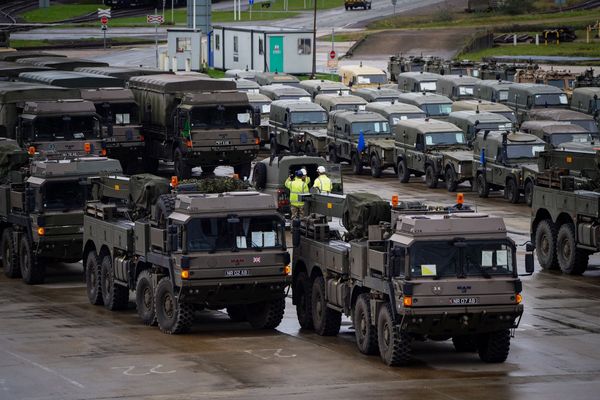
Amid the COVID-19 pandemic, Central Asian nations—Kazakhstan, Uzbekistan, Turkmenistan, Tajikistan, and Kyrgyzstan—are facing a particularly challenging test of their governments, health care systems, and fledgling economies, which are heavily dependent on commodity exports to global economic engines such as China. Unlike many other developing countries left isolated by the pandemic, they have a choice of great-power backers, as China, Russia, and the United States compete to offer aid. After recently rolling out its Central Asia strategy, the United States’ resolve to play against other great powers in a new Great Game faces its first major test in COVID-19. Although the United States may never wield as much influence in Central Asia as immediate neighbors such as Russia and China, engaging the region is necessary if it seeks to avoid ceding power and influence to China, especially in the wake of COVID-19. And to engage, the United States must offer alternatives to China and Russia that help Central Asian governments defeat COVID-19, resist domination, maintain stability, and continue reforms.
As laid out in its strategy, the United States’ first policy objective is to help Central Asian states maintain sovereignty and resist domination by the other great powers. Great-power competition is, in part, a competition for strategic influence over precious resources. To compete with Russia and China globally, the United States must force them to commit more attention and resources in Central Asia, a region long under Russia’s political dominion yet increasingly economically dependent on China.
In addition, any bandwidth China and Russia invest there is effectively diverted from other strategically significant regions such as the South China Sea, the Arctic, the Indian Ocean, and Italy—alarmingly, a recent addition to China’s Belt and Road Initiative. COVID-19 has accelerated a need for resources that in turn offers an opportunity for the United States to engage. It must open a new front, away from traditional friction points, to frustrate the ambitions of China and Russia, which now openly cooperate to impede U.S. foreign-policy goals around the world.
Central Asia is more than just one such front; strategically, the region matters. Relative to its population and economy, no other region is enmeshed in as many pressing geopolitical issues such as energy, trade, religious extremism, conflict in Afghanistan, a hostile Iran, nuclear rivalry in South Asia, the international opium trade, Russian aggression in its “near abroad,” instability in China’s Xinjiang province, and China’s Belt and Road Initiative.
Russian political and security interests have increasingly converged with those of China as each seeks to assert itself—Russia to maintain its sphere of influence and buffer against extremism, and China to stabilize its western flank from unrest tied to its persecution of Muslims and Turkic peoples. India, too, sees opportunity, in its case to open a second strategic front against its rival Pakistan by gaining influence over economic and security matters, particularly in Tajikistan. And Iran has developed closer economic and cultural ties with both Tajikistan and its neighbor Turkmenistan. Thus far, the political uncertainty associated with the changing of the guard from Soviet-era dictators to new leaders—some with their own autocratic ambitions—has incited deeper engagement from all parties but the United States.
Critics of U.S. engagement in Central Asia might prefer to let China and Russia compete alone at no cost to the United States. But to the extent that was ever possible with Russian power in decline, COVID-19 has changed the dynamic. Russia’s ability to exert influence in Central Asia grows weaker as its overwhelmed and underprepared health care system is under siege at home and its government coffers are underfilled amid low oil prices. Rather than compete directly with China, Russia increasingly looks to forge partnerships with it—on missile defense, military exercises, energy deals, and cooperation against the United States in Syria and the Korean Peninsula. Although the history of Sino-Russian distrust will likely always burden and constrain the relationship, Russia is likely to cooperate with China as it is less able than ever to take advantage of COVID-19 by mounting a competing effort for influence in Central Asia.
Facing little competition in Central Asia from either Russia or the United States thus far, China has seized the initiative in the wake of COVID-19. It has trumpeted its early experience dealing with the virus to advise governments such as Uzbekistan on mitigation. Its quicker economic recovery has positioned it to resume purchases of the numerous commodities, including oil from Kazakhstan, on which the Central Asian economies depend. It has provided medical equipment throughout the region. And true to form, it has negotiated potentially billions of dollars in loans to Kyrgyzstan and Uzbekistan, including through the China-led Asian Infrastructure Investment Bank. Meanwhile, the United States has provided medical equipment worth just $4.3 million to the region, though the administration of President Donald Trump has reportedly offered $274 million to assist Central Asia in battling the pandemic.
That level of serious engagement bucks a historical trend of only nominal U.S. investment in the region. After 1991, when Central Asian countries earned newfound freedom as the Soviet Union dissolved, the United States adopted an optimistic but narrow view of their strategic value. Efforts to appease a post-Soviet Russia, concern about proliferation of former Soviet weapons of mass destruction, and a desire for access to the region’s well-known oil and gas wealth drove a limited and focused U.S. foreign policy. At the turn of the century, that focus shifted to the global war on terrorism. Since 2001, U.S. interest in Central Asia has only marginally extended beyond counterterrorism and support to the war in Afghanistan.
Before COVID-19, the United States vacillated on Central Asian policy, with shifting emphases on human rights, governance, and security as preconditions to building stronger partnerships. In 2005, four years after the U.S. began basing military forces in Uzbekistan—and after more than $400 million in aid, despite then President Islam Karimov’s abysmal human rights record—it balked at his government’s brutal repression of protests in Andijan, which ultimately resulted in the expulsion of U.S. forces from the Kharshi-Khanabad air base. In 2005, the U.S. government welcomed the Tulip Revolution in Kyrgyzstan as a glimmer of progress towards anti-corruption and democracy. Yet in 2009, the U.S. ambassador to Kyrgyzstan cabled Washington that the son of Kyrgyzstan’s then President Kurmanbek Bakiyev was “smart, corrupt, and a good ally to have.” Over the same period, the United States limited its ambitions in the region so as not to upset the strategic balance with Russia. With Russian cooperation necessary to maintain military bases and the Northern Distribution Network supporting operations in Afghanistan, the United States even renamed its small base in Kyrgyzstan the Transit Center at Manas to highlight its temporary noncombat nature, minimizing any apparent threat to Russian security domination. Since Russian pressure on Kyrgyzstan’s government resulted in the forced closure of the Manas base, the United States has been largely restrained in the region. As a result, a long list of ambitious U.S. foreign-policy objectives envisioned in 2002 has gone mostly unfulfilled.
However, COVID-19, transitions of political power, economic reforms, and public concerns about Chinese and Russian domination have created new openings for the United States. Though Central Asian dictators have long sought to extract maximum concessions from the United States without legitimate interest in a long-term strategic relationship, new opportunity for rapprochement is worth exploring.
The growing dominance of China, combined with changes in political leadership, is an opportunity for the United States to build stronger relations with Uzbekistan and Kazakhstan. Both countries have undergone their first transitions of power, albeit from former communist dictators to those dictators’ protégés. While their reform agendas may demonstrate calculated pragmatism more than genuine commitments to liberal democracy and free markets, any reforms facilitating democratic governance, increased respect for human rights, and markets opened to U.S. investment are nonetheless positive progress.
To compete with Russia and China, the United States must find willing governments in Central Asia and build substantive partnerships with them that drive real impact and results. It must strengthen the political and security relationships needed to combat extremism. It must create conditions for U.S. businesses to invest. And, despite the potentially authoritarian aims of new leaders in Uzbekistan and Kazakhstan, the United States can influence the arc of those governments by creating incentives for further democratic, human rights, and economic reforms.
Central Asian regimes have depended and will continue to depend on strong economic relationships with China, but their concerns about Chinese intentions and debt diplomacy—exacerbated by the COVID-19 borrowing frenzy—are growing steeply. The United States is as well positioned as China to provide advice, equipment, and other aid to help Central Asian governments defeat the pandemic. Beyond COVID-19, it should offer alternatives to the Belt and Road Initiative for strategic development projects through its public investment programs and public-private partnerships. U.S. agencies should work with Central Asian governments to enact regulatory reforms and open their economies to private investment. And the State Department and U.S. Agency for International Development manage a multitude of diplomatic and aid programs the United States can bring to bear in support of continued reforms that resist both Russian and Chinese political influence toward authoritarianism.
As an alternative to both Russian and Chinese military domination, the United States can offer equipment and training that allow Central Asian countries to hedge their security dependences while opening markets for the U.S. defense industry. Many Central Asian countries are facing key procurement decisions as they are forced to replace obsolete Soviet-era military equipment; the equipment they purchase will require decades of spare parts, training, and tactics that will form the core of their security relationships going forward.
Russia and China are more than willing to address their modernization needs with heavy subsidies, but without the same governance and human-rights strings attached. Increased U.S. security assistance can provide Central Asian countries with tools and incentives to cooperate closely with the United States against regional extremist groups, an important U.S. security interest. Furthermore, unlike that of competitors, increased U.S. security assistance would subject potentially unscrupulous actors to the strictest, albeit imperfect, human-rights protections on military equipment sales and use in the world.
The United States cannot cede its opportunity in Central Asia to Russia and China. With even a limited commitment of resources, it can inhibit the detrimental effects of their activities, defeat COVID-19, and improve the lives of the region’s 72 million people—causes consistent with its own Central Asia strategy and worthy of its attention.







